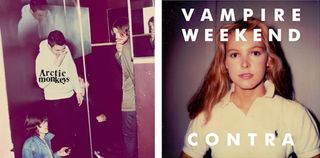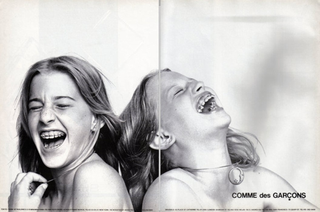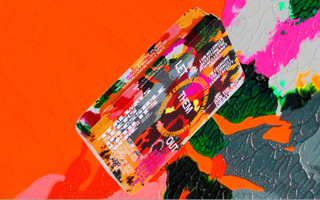3 trends from the 2010s that are very much back in vogue
Soft grunge and moody palettes are here to stay.
When it comes to trends, it’s typically nostalgia that shapes the cyclical patterns we see emerging time and time again. Just as the '90s and Y2K have had a massive influence on recent design trends through millennial kitsch colour palettes and retro 90s-inspired web design, the 2010s look set to be the next decade to start making a comeback in branding.
While it really wasn’t long ago, the 2010s was a decade of eclectic and evolving aesthetics from indie sleaze and moodier grunge revival, to twee indie and hipster trends inspired by the '60s and '70s. These were the years that the internet totally transformed popular culture thanks to platforms like Tumblr and Instagram gaining traction. Tumblr in particular laid the foundations for social media as we know it today, bringing subcultures and fandoms into the mainstream in new, globally accessible ways that celebrated community and shared creativity.
What has become recognisable as a ‘Tumblr aesthetic’ is an intentionally unique collage of different styles that elevate individualism and personal expression in a way that makes it ideal for new generations to revive with a new spin.
So while there is no homogeneous ‘look’ from this decade, as the teenagers of the 2010s become more influential decision-makers in the workforce, it’s not surprising that we’re seeing some of the nostalgic, eclectic aesthetics of these platforms make more of a comeback. These are just some of the ways visual trends of 2010s online culture are influencing brands today:
01. Grainy lo-fi photography

The power of 2010s-fuelled nostalgia lies in its ability to transport people back to an often slightly undefined era. For example, early in this decade, artists and bands like The Arctic Monkeys and Vampire Weekend popularised a grainy photography style that was intentionally hazy and nostalgic, romanticising '90s grunge in a way that made it almost timeless. A similar aesthetic approach permeated campaigns from brands like All Saints and Comme des Garçons throughout the decade, with a focus on capturing natural rather than staged moments.

Lo-fi digital imagery and polaroid-like filters dominated Instagram in the early 2010s, capturing the raw, candid imagery that initially defined the platform before the rise of a more sanitised and professional influencer culture. Today, as consumers fatigue of the ultra-curated and retouched social content that’s become ubiquitous across different platforms, we’re seeing a resurgence of this rougher, faded aesthetic in branded content.
With brands like Urban Outfitters, Free People and Youthforia embracing this quasi-underground, unpolished aesthetic in their photography more than a decade later, the style seems to resonate particularly well with Gen Z audiences who prize authenticity above all else.
Get the Creative Bloq Newsletter
Daily design news, reviews, how-tos and more, as picked by the editors.
02. Eclectic collage and mixed media

In the early 2010s, creatives gravitated towards a burgeoning DIY ethos on both Tumblr and Instagram, sharing unpolished, often unfinished, work on their grids. One of this year’s biggest design trends, cluttercore, can trace its roots back to the eclectic Tumblr aesthetics of the 2010s, embracing creative experimentation and imperfection in sometimes chaotic ways.
Much like the platform’s content and community-building, this trend is all about identity and passion. At its heart is an underlying principle of self-expression and celebration of individuality, with overlapping graphics, torn edges, textures and messy collage-like effects combined with bright and often clashing colours to great effect.
Another backlash against pristine digitally manipulated images, this current design trend, with its overlapping graphics and messy collage-like effects, is reminiscent of the digital scrapbooking that defined the height of Tumblr’s success.
03. Soft grunge and moody palettes

While indie sleaze of the 2010s was rooted in grunge, it tended towards a low-effort, saturated colour palette captured with flash photography. But there was also a grunge-inspired aesthetic prevalent online around the same time that combined darker, moodier tones mixed with softer pastels and more feminine elements - and it seems this trend is re-emerging today in trends such as 'grunge coquette' in interior design.
Similarly, we can see other integral elements of the grunge Tumblr girl aesthetic that this trend represents showing up in a number of popular brands today including Dr Martens and All Saints. While All Saints lean into the trend in its packaging and store design, some brands have gone even further with Faber-Castell Cosmetics launching an entire Soft Grunge collection.
While it’s yet to be seen if these trends will have lasting impact on branding of the future, the 2010s were a decade of significant digital disruption: visual culture was forever changed as a result of online platforms that fundamentally altered our social fabric. It’s no surprise that in finding ourselves in a period of even more rapid technological change, we start to see trends revived from this time: a time that now, looking back, seems much simpler.

Thank you for reading 5 articles this month* Join now for unlimited access
Enjoy your first month for just £1 / $1 / €1
*Read 5 free articles per month without a subscription

Join now for unlimited access
Try first month for just £1 / $1 / €1

Patrick Llewellyn is CEO of 99designs by Vista, the global creative platform that makes it easy for small businesses to work with professional freelance designers around the world. 99designs has paid out more than US$400m to its creative community to date, working across brand and logo design, packaging, web design and more.